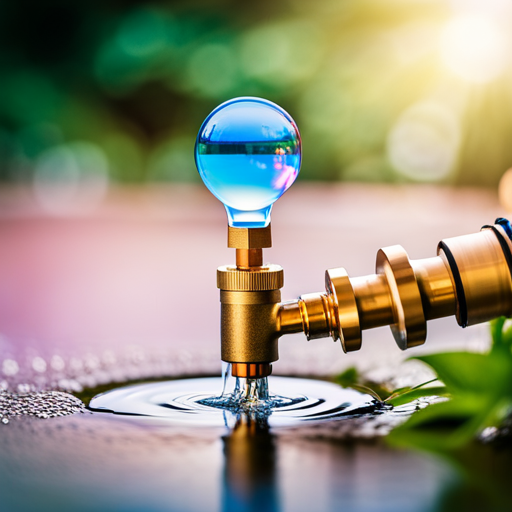Are you tired of dealing with the negative effects of hard water on your appliances and utility bills? A water softener can be the solution you’ve been looking for, but it’s important to ensure that it’s installed safely and in compliance with local plumbing codes.
One vital component to consider is a backflow preventer, which is crucial for keeping contaminated water from flowing back into the main water supply.
In this article, we’ll explore the importance of backflow preventers in water softeners and how they help ensure that your soft water is also safe water. We’ll discuss whether you need a backflow preventer, the local regulations and requirements you need to know about, and the benefits of having one installed.
With the right knowledge and precautions, you can enjoy the benefits of soft water without compromising the safety of your water supply.
Key Takeaways
– Backflow preventers are crucial components in water softeners to prevent contaminated water from flowing back into the main water supply.
– Different types of backflow preventers include Double Check Valve Assemblies, Reduced Pressure Zone Assemblies, and Atmospheric Vacuum Breakers.
– Consulting with a licensed plumber is important to determine the best type of backflow preventer and ensure proper installation.
– Compliance with local regulations is important to ensure safe and clean water.
Do I Need One?
If you’re using a water softener on your main water supply, you’ll likely need a backflow preventer to comply with local regulations and ensure contaminated water doesn’t flow back into the main supply. While it may seem like an added expense, there are some benefits to having a backflow preventer installed.
For one, it helps keep your water supply safe and clean, protecting you and your family from potential health hazards. Additionally, it can help save you money in the long run by reducing the risk of costly repairs due to contaminated water damage.
However, it’s important to keep in mind that a backflow preventer does require some maintenance. This includes regular inspections and testing to ensure it’s working properly and hasn’t become clogged or damaged. There may also be some upfront costs associated with installation, but the peace of mind that comes with knowing your water supply is safe and clean is worth it.
Be sure to factor in the pros and cons, as well as maintenance cost, when deciding whether or not to install a backflow preventer with your water softener. Do not forget that you’ll have to do the maintenance.
Importance of Backflow Prevention
To ensure the safety of your water supply, it’s essential to have a backflow preventer installed when using a water treatment system on your main water line. Backflow prevention is crucial because contaminated water could potentially flow back into your home’s water supply, leading to serious health hazards.
Here are some benefits and types of backflow preventers to consider:
1. Benefits of Backflow Prevention
Backflow prevention not only ensures safe drinking water, but it also helps avoid costly repairs to your plumbing system. By preventing contaminated water from entering your home’s water supply, you’ll avoid the need to replace appliances, pipes, or fixtures that could become damaged by contaminated water. Additionally, backflow prevention helps avoid potential legal liabilities that could arise if contaminated water enters your home’s water supply.
2. Types of Backflow Preventers
There are several types of backflow preventers, and the type you need will depend on your specific water supply and local regulations. Some common types include Double Check Valve Assemblies (DCVAs), Reduced Pressure Zone Assemblies (RPZs), and Atmospheric Vacuum Breakers (AVBs).
DCVAs are typically used in residential settings, while RPZs are often used in commercial or industrial settings. AVBs are generally used for irrigation systems or outdoor faucets. It’s important to consult with a licensed plumber to determine the best type of backflow preventer for your specific water supply and needs.
Local Regulations and Requirements
Check your local plumbing codes to ensure that you comply with the requirements for installing a backflow preventer when using a water softener on your main water supply. Different areas have different regulations regarding the type of backflow preventer needed and the installation process.
It’s important to do your research and ensure that you’re following the guidelines set forth by your local building department.
There are different types of backflow preventers available for use with water softeners, including pressure vacuum breakers, double check valves, and reduced pressure zone devices. Each type serves a specific purpose and provides a different level of protection against backflow.
It’s important to consult with a professional plumber to determine the most appropriate type of backflow preventer for your specific situation and to ensure proper installation.
By complying with local regulations and installing the appropriate backflow preventer, you can ensure that your water is both soft and safe for use.
Conclusion
So, now that you know the importance of backflow preventers for water softeners, you may be wondering if you need one. The answer is most likely yes, especially if you live in an area with strict plumbing codes.
Even if your area doesn’t require a backflow preventer, it’s still a good idea to have one installed for the safety of your family and community.
Remember, soft water is not always safe water. Without a backflow preventer, contaminated water can easily flow back into the main water supply and cause serious health hazards.
So, don’t take any chances and make sure to have a backflow preventer installed with your water softener. Your appliances and utility bills will thank you, and most importantly, your family’s health will be protected.
